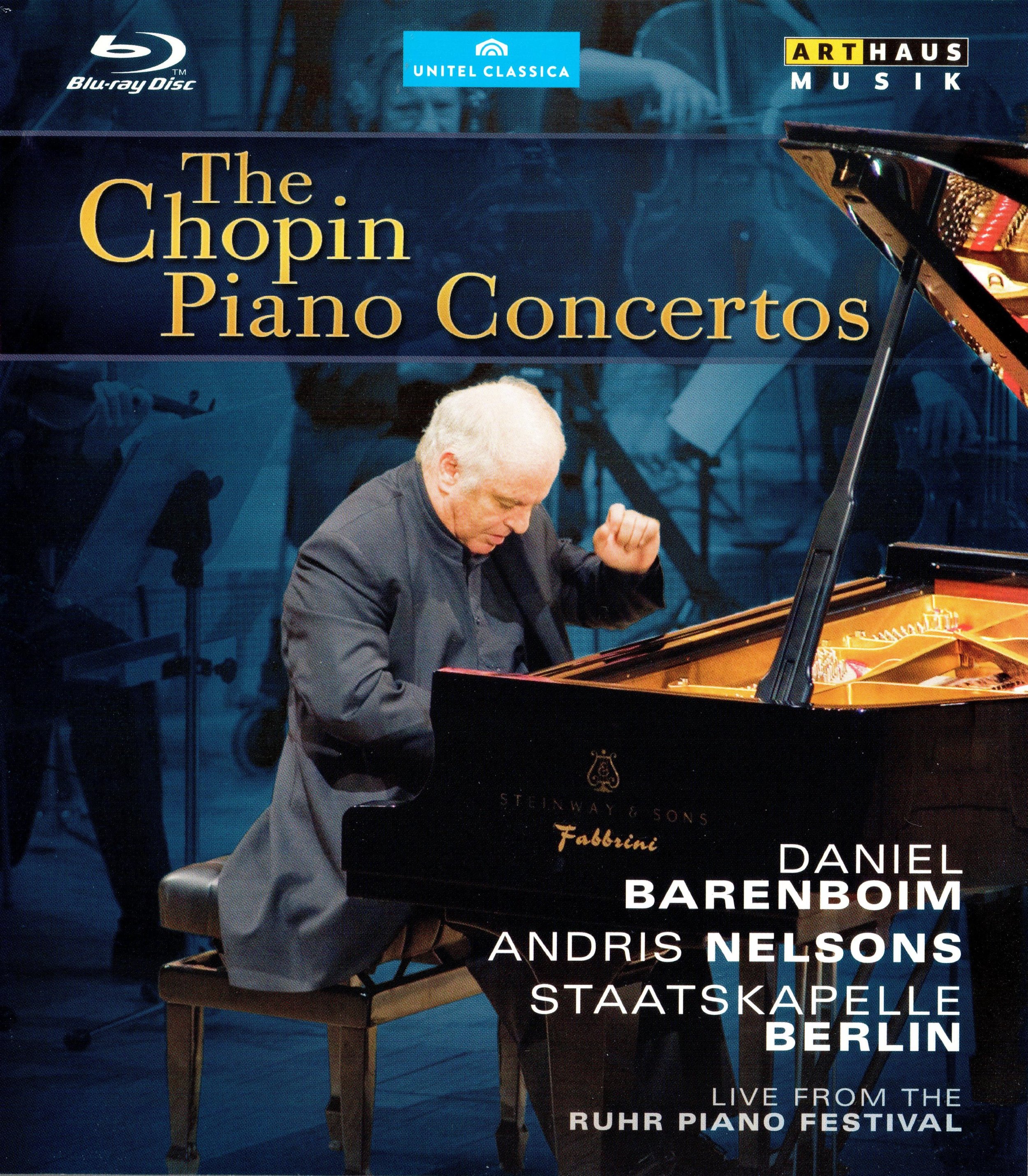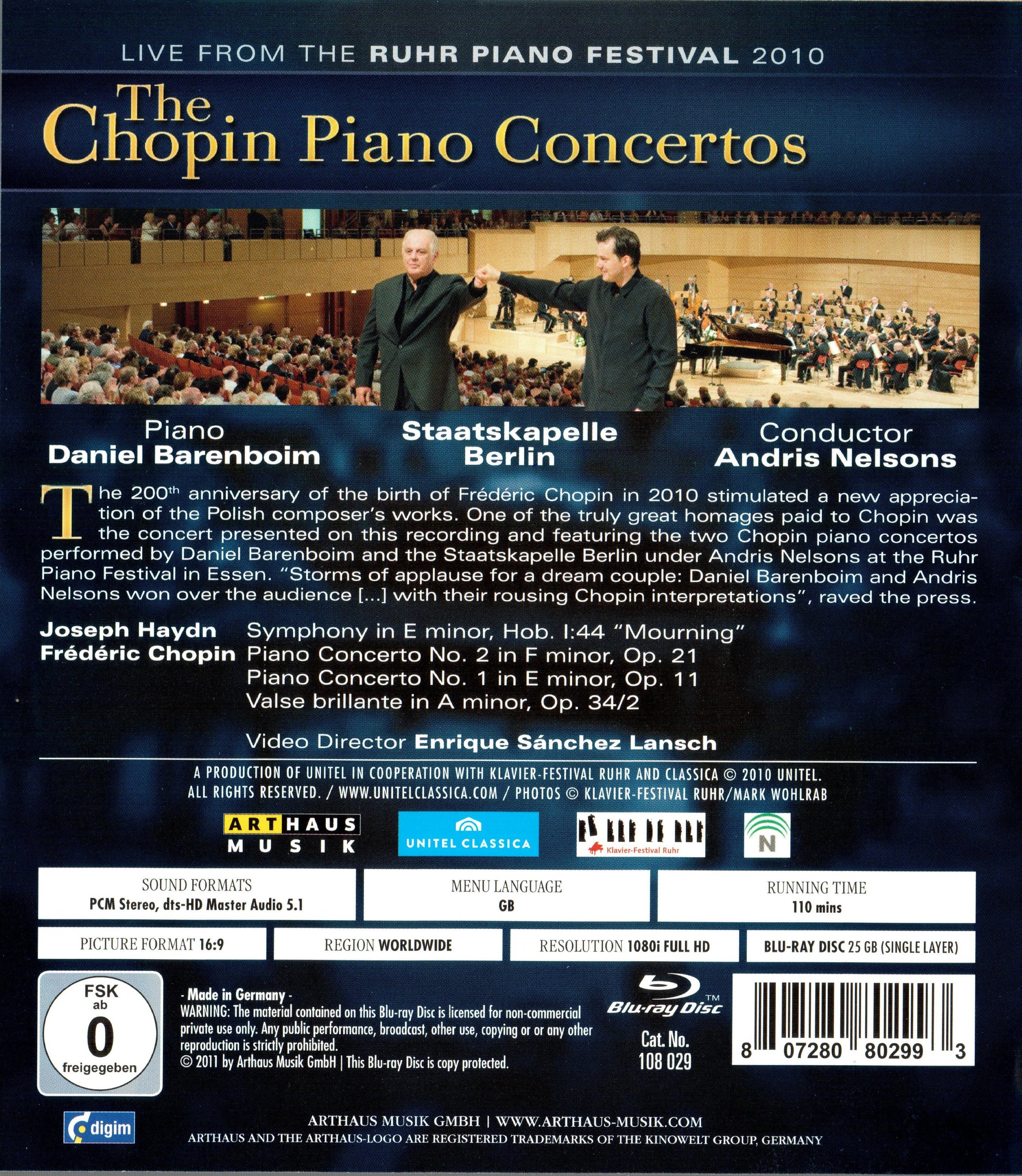

Chopin Piano Concertos 1 & 2 concert played by Daniel Barenboim at the 2010 Ruhr Piano Festival with the Staatskapelle Berlin conducted by Andris Nelsons. Barenboim plays the Chopin Valse brillante in A Minor as encore. Also includes a performance of the Haydn Symphony in E minor ("Mourning") by the Staatskapelle Berlin and Nelsons. Directed for TV by Enrique Sánchez Lansch; director of photography was Nyika Jancsó; produced by Paul Smaczny. Released 2011, disc has 5.1 dts-HD Master Audio sound. Grade: D+
PQ is poor throughout this disc with weak resolution. It seems there was plenty of light, but even close-up shots of soloists aren't sharp. Waist shots of Nelsons are fuzzy as are the notes on the sheet music. But the lack of resolution really shows up at 3:34, where we see a 100% whole-orchestra view. This image is quite dull.
The SQ is similar to the Demidenko/Kissin recording of the Chopin concertos, i.e., better than CDs but not audiophile quality either. In the concertos, the balance between the orchestra and the piano soloists seems be off with the orchestra sometimes hard to hear during the piano passages.
Haydn "Mourning" Symphony
This was a warm up with reduced chamber-orchestra forces.
Surely with this small formation we should get plenty of the whole-orchestra shots that are a hallmark of a good HDVD of a symphony. Well, hold your breath.
Preliminary shots of the players at :35 and :55 don't count. They are too short or too long-range to show us how the orchestra is organized and what players are on the stage. Presently Nelsons starts, and mini-disaster strikes immediately. Jancsó has managed to put his rear camera on the exact spot where any shot of Nelsons will also have an out-of-focus snout of bassoon sticking up "in front" of Nelsons. (By the end of this short symphony, the bassoon will be at rest. Later, positions will change and the bassoon will be out of the way.) There then follows, as is typical of a DVD, a bunch of quick cuts from the conductor to various individual players. Finally (still holding your breath?), at 3:34 we arrive at the single whole-orchestra shot we get in this symphony. Now the truth hits home. The resolution of the cameras is too weak to comfortably show all of even a chamber orchestra. This video is closer to a DVD than an HDVD.
There are a number of decent part-orchestra shots during the symphony. That's the best the camera crew could do. And there is a decent shot at 15:00 of two oboes and two horns. But that's about all to praise. The rest is an exhausting string of rapid cuts between the conductor, single players, and small groups that too often have no obvious relation to the music. There is also a lot of DVD-style panning around in a sea of strings.
All this hyper-action is a senseless waste of energy when you consider the simplicity and serenity of this Haydn symphony. All the video director needs to do (if he can come up with a real HD picture) is to languidly rotate among 3 or 4 whole-orchestra or large-part-of-orchestra shots and let the viewer look around at this leisure. The TV director would also sharply limit shots of Nelsons, who was born making faces and will never stop. We are not giving a grade on the Alphalist for this part of the recording — but if we did, it would have to be a D.
Chopin Concerto No. 2 (played first)
It's astonishing all the works that Barenboim can play as soloist while also serving as conductor in multiple houses in different countries. Still, you would not expert him to be fully competitive with artists like Demikenko and Kissen who only play the piano and specialize in Chopin to boot. So for Barenboim to sell HDVDs of Chopin concertos, everything else about the disc has got to be really good.
Now the whole orchestra is on the stage. Since, as we already saw, poor video resolution will not allow a whole-orchestra shot of a chamber orchestra, there can obviously be no whole-orchestra shot during the concerto. At 24:12 there is an audience shot (taking up 80% of the frame) which also shows tiny images of the orchestra players on the stage (filling the remaining 20% of the frame.) This view is repeated at least 4 times. This doesn't count as a whole-orchestra shot because you can't tell anything about who the players are or that they are doing. There is a marginal part-orchestra shot at 30:49 (repeated several time), but it doesn't show the 1st violins.
There are 194 video cuts in this short concerto. More than half belong, of course, to Barenboim. Nelsons gets 36 shots of which 12 are made over the backs of players. There are about 15 decent part-orchestra shots. The rest of the video consists of DVD-like quick cuts from the conductor to various individual players or small groups.
Barenboim plays with his trademark percussive vigor. At 30:49 there is an example of poor balance in the sound when the orchestra can barely be heard. Barenboim sounds rough at times, especially between 33:35 and about 35:17.
Chopin Concerto No. 1
The video of Concerto No. 1 is similar to what is described above. During this segment we also noted focus and field-of-focus issues. See 1:04:14 for one of many frames where the cameraman has difficulty keeping focus on the pianist's hands at the keyboard. Sometimes nothing seems in focus; often maybe 3 keys can clearly be seen. Note the name "Steinway & Sons" on the keyboard dust cover just above the player's hands. The famous name is mostly blurred, and sometimes you can see twitching in the image as the cameraman tries to get focus under control.
Barenboim's percussive performance style here contrasts sharply with the Demidenko "poetic" performance of this work. Towards the end, Barenboim seems to tire, and we hear raggedness in his runs. For sure, we don't hear Barenboim on that other planet with Chopin. We hear him as all too mired on planet earth, doggedly driving through heady traffic trying to get home without smacking a fender.
What grade does this title deserve? Although the audience applauded Barenboim warmly, we think his live performance would deserve an B+ at best. Then the grade must be reduced for poor resolution, weak video content as to the orchestra, focus issues, the bassoon snout in the Hadyn, Nelson's faces, and unexceptional SQ. We keep in mind also that there are competing HDVDs on the market now of these concertos. This leads us to the grade of D standing for "don't buy this unless you have a really good reason." But solely out of respect for Barenboim, we nudge the grade up to D+.